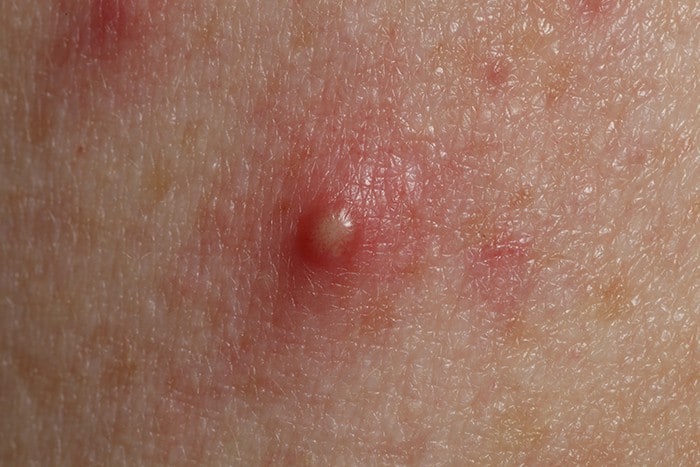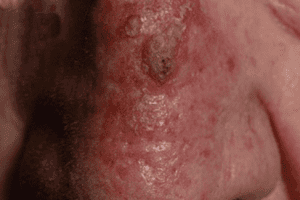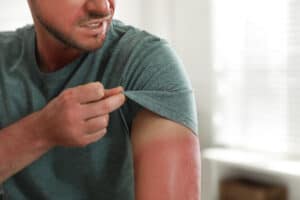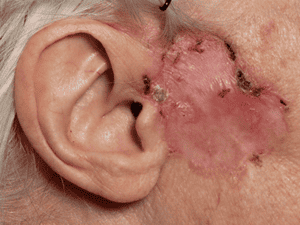Actinic Keratosis
Home » Conditions » Actinic Keratosis
Skin Cancer Can Be Fatal
Not sure about your condition? Get in touch now, there is no reason for you to wait.
Award winning dermatology service, with over 20 years of experience
Short waiting lists, on some occasions offering same week appointments
Safe environment, in Care Quality Commission approved facilities
actinic keratosis treatment uk
Actinic keratosis, also known as solar keratosis, sunspots, and sun damage are ill-defined rough patches, ranging in colour from pink to brown and measuring from 0.5 to 3cm in width. Some can resemble crusty outgrowths when they are particularly thick and raised.
If an AK starts to bleed or rapidly change in appearance or size this may indicate that it is progressing toward squamous cell carcinoma and medical advice must be sought immediately.
Actinic keratosis is usually harmless, though they can be itchy and feel rough to the touch. Some people also find their appearance unsightly, particularly when they are on the face.
Alternative names: solar keratosis, sunspots, sun damage.
WHAT DOES ACTINIC keratosis LOOK LIKE?
Actinic keratosis is ill-defined rough patches, ranging in colour from pink to brown and measuring from 0.5 to 3cm in width (see figure). Some can resemble crusty outgrowths when they are particularly thick and raised.
If an AK starts to bleed or rapidly change in appearance or size this may indicate that it is progressing toward squamous cell carcinoma and medical advice must be sought immediately.
WHAT ARE THE SYMPTOMS OF ACTINIC keratosis?
It can sometimes be hard to tell if you have actinic keratosis so it is worth checking with a consultant dermatologist if you are worried. Patches of actinic keratosis are usually rough to touch and range in colour from pink to brown. They can measure anywhere between 5mm and 30mm in width and can be thick and raised from the skin. They are often sore or itchy. If an area of your skin which resembles these characteristics starts to bleed, hurt or rapidly change in appearance or size, this may indicate that it is progressing toward squamous cell carcinoma, a form of skin cancer, and must be assessed by a consultant dermatologist as soon as possible. View actinic keratosis images below.
actinic keratosis images:



HOW CAN ACTINIC keratosis BE TREATED in the uk?
Actinic keratosis is usually little cause for concern, and small patches may regress by themselves. However, it is important to adopt good sun-protection habits such as using sunscreens and wearing protective clothing on hot days, to prevent further skin damage.
Due to the small risk of progression to skin cancer, it is generally advisable to treat actinic keratosis. They can also be removed to improve the cosmetic appearance of the skin as a matter of personal choice. A variety of actinic keratosis treatments are available and include:
- Creams and ointments (5-fluorouracil, imiquimod or diclofenac sodium): these can be used when there are a large number of actinic keratosis, for example on the scalp.
- Photodynamic therapy: employs the use of a special cream, which is applied to affected areas and is activated by light of a specific wavelength.
- Cryotherapy: involves freezing an affected site with liquid nitrogen.
- Curettage or excision: this is performed under local anaesthetic and normally reserved for thicker patches and suspected skin cancers.
Though these options are highly effective, due to prior sun-damage it is likely that more actinic keratoses will develop in the surrounding skin, requiring future treatment.
Our Dermatologists at the Harley Street Dermatology Clinic can offer effective treatment for all types of sun damage including actinic keratosis.
Frequently Asked Questions
DOES ACTINIC KERATOSIS TURN INTO SKIN CANCER?
Actinic keratosis is not life-threatening and small patches may disappear on their own but some actinic keratosis can turn into squamous cell skin cancer so can be considered as precancerous. If they are found and treated early, they do not have the chance to develop into skin cancer.
WHAT DO PATCHES OF ACTINIC KERATOSiS LOOK LIKE?
The patches can feel like sandpaper, they are dry rough and scaly. They usually range in size from 1cm to 2cm and can be itchy. They can either be the same colour as your skin, pink, red or brown.
WHERE ON THE BODY DO ACTINIC KERATOSIS USUALLY APPEAR?
As the patches of actinic keratosis are caused by exposure to the sun, they are most commonly found on areas of the body which are exposed to the sun such as the face, hands, arms, legs, ears and scalp.
WHAT CAN I DO IF I HAVE ACTINIC KERATOSIS?
If you have patches of actinic keratosis, it is important to get them checked by a dermatologist to reduce the risk of them developing into skin cancer. To stop getting further patches and to look after your skin it is important to:
- use sun cream before exposing your skin to the sun
- wear clothing which will protect your skin from the sun
- do not use sunbeds or sunlamps
- avoid the sun when it is at it’s strongest (between 11am and 3pm)
HOW CAN ACTINIC KERATOSIS BE PREVENTED?
Actinic keratosis is usually little cause for concern. Small patches may disappear by themselves. However, it is important to adopt good sun-protection habits.
As actinic keratosis is caused by exposure to the sun, the key to prevention is avoiding the sun when its rays are most intense, especially around the middle of the day. Before going outdoors follow the usual sun safety measures of applying sunscreen with a high SPF and protection from both UVA and UVB light and wearing clothes designed to provide sun protection. It is also important to follow these steps if you already have signs of actinic keratosis in order to reduce the chances of them developing into skin cancer.
HEAR FROM OUR PATIENTS
Start Your Journey With Us
Please fill in this form and one of our team will give you a call back to arrange a consultation with one of our expert dermatologists.
WHY TREAT YOUR ACTINIC keratosis AT THE HARLEY STREET DERMATOLOGY CLINIC?
Having the right dermatologist is important especially when you have a chronic skin condition that will require ongoing treatment. We want you to feel confident that we’re providing you with the best possible care. We also want you to feel as comfortable as possible with your dermatologist.
The Harley Street Dermatology Clinic specialises in conditions affecting the skin, hair and nails. Our goal is to provide all the care that you need when you’re experiencing these kinds of problems. We want to make it easy for you to access the best quality actinic keratosis treatment and support in London.
The clinic is conveniently located in Central London, so it’s easy to visit us if you need to see a dermatologist. You will find yourself in a very comfortable and welcoming environment. We have created a relaxing space where you will receive the highest quality of care. We are regulated by the Care Quality Commission, are part of the British Association of Dermatologists and are top-rated by patients of Doctify so you can be sure of safe and effective actinic keratosis treatment with us.
INSIGHTS AND ADVICE

Ask The Expert: Sun Damage
WHAT DO I DO IF I BURN MY SKIN? Ideally, with the right high SPF sun cream and caution, sunburn can be avoided completely. However, in cases where sunburn happens, it is important to begin treating as soon as possible and get out of the

Worried about a mole?
A mole is a coloured spot on the skin which is made up of a cluster of cells known as melanocytes which are responsible for producing the pigment in your skin. Sometimes these melanocytes grow in a cluster instead of being spread out which results

Is BCC (Basal Cell Carcinoma) a Completely Curable Disease? How?
You might not have heard of Basal Cell Carcinoma before, but it is actually the most common form of skin cancer in the UK. About 80% of the people who are diagnosed with skin cancer every year have a BCC. If you are diagnosed with







